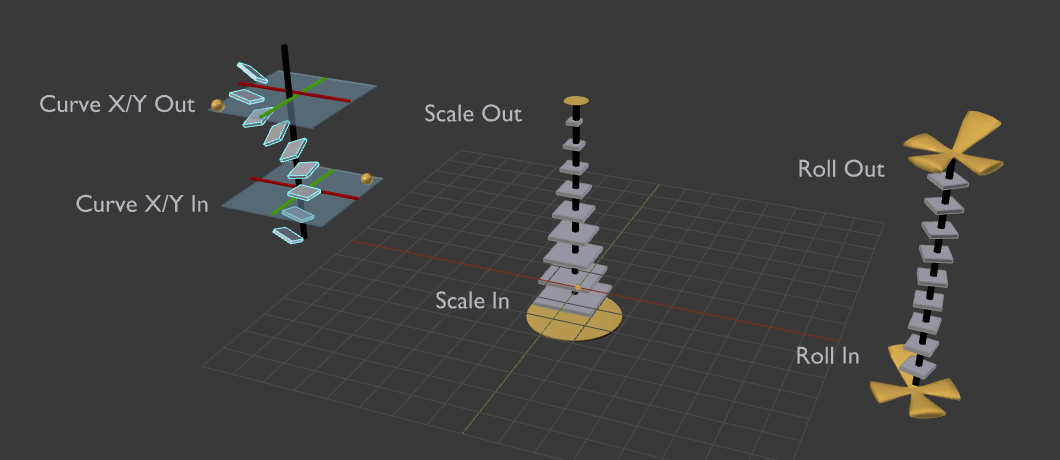柔性骨骼(软骨骼、样条骨)¶
参考
- 模式
所有模式
- 面板
柔性骨骼(B-Bones)是取代许多小型刚性骨骼长链的简单方法。弯曲骨骼主要用于脊柱模型或面部骨骼。
技术细节¶
Blender将柔性骨骼看成通过骨骼关节的贝塞尔曲线一部分. 每个 段数 将弯曲并滚动以遵循这看不见的贝塞尔曲线代表此的曲线细分点。曲线两端的控制点是骨骼的端点。样条骨(B-bones)的形状可以是受控制使用一系列的属性或间接邻近的骨骼(即第一个子级和父级). 骨骼两端的手柄以控制曲率。
当使用 B-bone 作为约束目标 数据ID 会提供跟随曲线的选项。
Note
但是,如果将骨骼用作目标而不是变形网格物体,则只有 骨架 和 复制变换 约束将使用包括滚动和缩放的完整变换。
显示¶
只有骨骼视图显示设置为为 样条骨(B-bones) 才能看到这些段数。
当视图显示不是 样条骨(B-bones) 时, 即使骨骼段数仍然存在并且有效,骨骼总是显示为刚性棍形。 这意味着即使在例如 八面体 可视化的显示方式,如果链中的一些骨头有分段, 他们仍然会使他们的几何体平滑变形...
重置姿势¶
柔性骨骼(B-bones)的初始形状可以在编辑模式中定义为该骨骼的重置姿势。这对弯曲的面部特征(如弯曲的眉毛或嘴巴)很有用。
B-Bones have two sets of the Bendy Bone properties -- one for Edit Mode (i.e. the Rest Pose/Base Rig) and another for Pose Mode -- adding together their values to get the final transforms.
例子¶
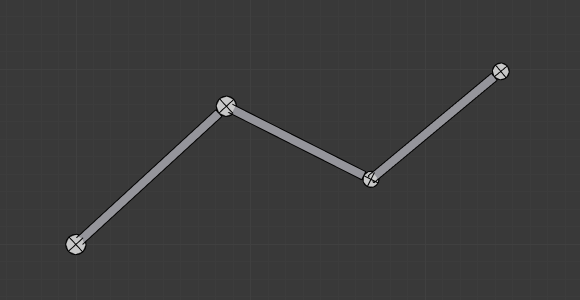
在编辑模式下只有一个段的骨骼。¶ |

贝塞尔曲线叠加在链上,其手柄放置在骨骼的两端。¶ |
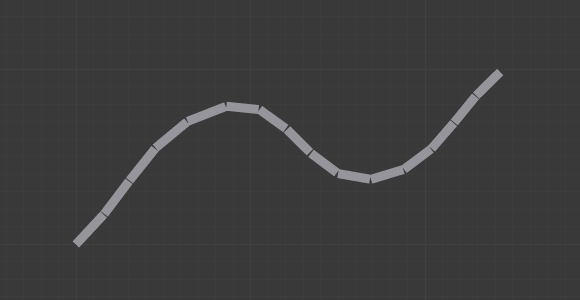
相同的骨架在物体模式。¶ |
在图 在编辑模式下只有一个段的骨骼。 我们连接了三个骨骼,每个骨骼由五段组成。
看图。 相同的骨架在物体模式。 ,我们可以看到骨骼的细分如何平滑地 "融合" 到彼此,即使是产生了滚动。
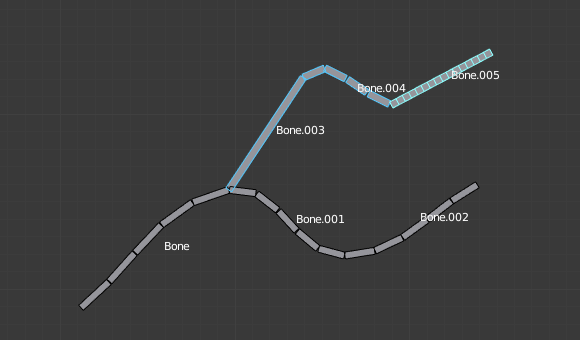
骨骼在姿态模式下显示效果: Bone.003有一段,Bone.004有四段,Bone.005有十六段。¶
选项¶
段数¶
The Segments number field allows you to set the number of segments, which the given bone is subdivided into. Segments are small, rigid linked child bones that interpolate between the root and the tip. The higher this setting, the smoother "bends" the bone, but the heavier the pose calculations.
Curve XY Offsets¶
Applies offsets to the curve handle positions on the plane perpendicular to the bone's primary (Y) axis. As a result, the handle moves per axis (XY) further from its original location, causing the curve to bend.
扭转¶
- Roll In, Out 滚入, 滚出
The roll value (or twisting around the main Y axis of the bone) is interpolated per segment, between the start and end roll values. It is applied as a rotational offset on top of the previous rotation.
- Inherit End Roll 继承尾端扭转
如果启用, 头端 骨骼(默认连接父项)的 滚入 值将添加入到当前骨骼的 滚出 设置中。
比例|缩放¶
- Scale In X/Y, Scale Out X/Y
Scaling factor that adjusts the thickness of each segment for the X and Y axes only, i.e. length (Z axis) is not affected. Similar to Roll it is interpolated per segment.
缓动¶
- 渐入,渐出
The Ease In/Out number fields, change the "length" of the "auto" Bézier handle to control the "root handle" and "tip handle" of the bone, respectively.
These values are proportional to the default length, which of course automatically varies depending on bone length, angle with the reference handle, and so on.
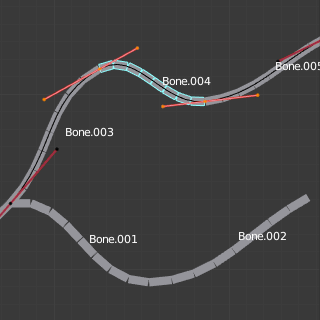
Bone.004的渐入和渐出值都为默认值(1.0)。¶ |
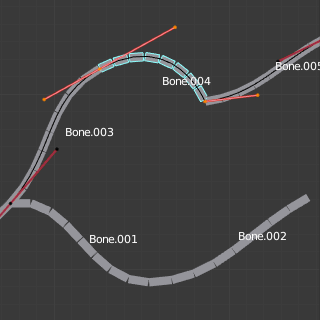
Bone.004的渐入的值为2.0,渐出的值为0.0。¶ |
自定义控制柄¶
B-Bones可以使用自定义骨骼作为其参考骨骼控制柄,而不是仅使用连接的父/子骨骼。
- Start, End Handle Type
从以下选项中指定控制柄的类型:
- 自动
选择骨骼的连接父级(或者连接的子级骨骼)作为控制柄。 计算根据下面的 绝对 控制柄类型完成。
- 绝对
The Bézier handle is controlled by the position of the head (tail) of the handle bone relative to the head (tail) of the current bone. Note that for this to work, there must be a non-zero distance between these bones. If the handle is also a B-Bone, additional processing is applied to further smooth the transition, assuming that the bones in effect form a chain.
- 相对
贝塞尔手柄由手柄骨的头部(尾巴)与其静止姿势的 偏移 控制。由于接近零偏移的数值稳定性问题,不建议使用此类型。
- 切向(正切)
贝塞尔手柄由手柄骨骼的 方向 控制,与其位置无关。
- 自定义控制柄
对于 自动 以外的控制柄类型,必须手动选择用作控制柄的骨骼。 切换到自定义句柄类型可以不选择骨骼来有效地禁用控制柄。
这种相关性应用于带有 自动 句柄的连接链中,两个骨骼作为控制柄相互引用是有效的。
Tip
插帧集
The "BBone Shape" Keying Set includes all Bendy Bones properties.
